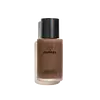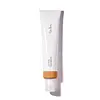What's inside
What's inside
 Key Ingredients
Key Ingredients

 Benefits
Benefits

 Concerns
Concerns

 Ingredients Side-by-side
Ingredients Side-by-side

Water
Skin ConditioningCoco-Caprylate/Caprate
EmollientC9-12 Alkane
SolventGlycerin
HumectantSilica
AbrasivePolyglyceryl-6 Polyricinoleate
EmulsifyingDextrin Isostearate
Skin ConditioningHydrogenated Coco-Glycerides
EmollientMagnesium Sulfate
Sodium Chloride
MaskingCamellia Japonica Seed Oil
EmollientCaesalpinia Spinosa Fruit Extract
Skin ProtectingKappaphycus Alvarezii Extract
Skin ConditioningPolyglyceryl-2 Isostearate
EmulsifyingC8-12 Acid Triglyceride
Skin ConditioningTrihydroxystearin
Skin ConditioningDisteardimonium Hectorite
StabilisingTocopheryl Acetate
AntioxidantPotassium Sorbate
PreservativeSodium Myristoyl Glutamate
CleansingChlorphenesin
AntimicrobialParfum
MaskingIsostearic Acid
CleansingAluminum Hydroxide
EmollientTocopherol
AntioxidantUltramarines
CI 77491
Cosmetic ColorantCI 77492
Cosmetic ColorantCI 77499
Cosmetic ColorantCI 77891
Cosmetic ColorantMica
Cosmetic ColorantWater, Coco-Caprylate/Caprate, C9-12 Alkane, Glycerin, Silica, Polyglyceryl-6 Polyricinoleate, Dextrin Isostearate, Hydrogenated Coco-Glycerides, Magnesium Sulfate, Sodium Chloride, Camellia Japonica Seed Oil, Caesalpinia Spinosa Fruit Extract, Kappaphycus Alvarezii Extract, Polyglyceryl-2 Isostearate, C8-12 Acid Triglyceride, Trihydroxystearin, Disteardimonium Hectorite, Tocopheryl Acetate, Potassium Sorbate, Sodium Myristoyl Glutamate, Chlorphenesin, Parfum, Isostearic Acid, Aluminum Hydroxide, Tocopherol, Ultramarines, CI 77491, CI 77492, CI 77499, CI 77891, Mica
Water
Skin ConditioningCoco-Caprylate/Caprate
EmollientGlycerin
HumectantPolyglyceryl-6 Polyricinoleate
EmulsifyingAvena Sativa Kernel Extract
AbrasivePrunus Persica Fruit Extract
AbrasiveTocopheryl Acetate
AntioxidantBiosaccharide Gum-1
HumectantSodium Anisate
AntimicrobialSodium Levulinate
Skin ConditioningMagnesium Sulfate
Sodium Salicylate
PreservativeEthylhexylglycerin
Skin ConditioningCitric Acid
BufferingGlyceryl Caprylate
EmollientPolyhydroxystearic Acid
EmulsifyingPotassium Sorbate
PreservativeCI 77491
Cosmetic ColorantCI 77492
Cosmetic ColorantCI 77499
Cosmetic ColorantCI 77891
Cosmetic ColorantWater, Coco-Caprylate/Caprate, Glycerin, Polyglyceryl-6 Polyricinoleate, Avena Sativa Kernel Extract, Prunus Persica Fruit Extract, Tocopheryl Acetate, Biosaccharide Gum-1, Sodium Anisate, Sodium Levulinate, Magnesium Sulfate, Sodium Salicylate, Ethylhexylglycerin, Citric Acid, Glyceryl Caprylate, Polyhydroxystearic Acid, Potassium Sorbate, CI 77491, CI 77492, CI 77499, CI 77891
 Reviews
Reviews

Ingredients Explained
These ingredients are found in both products.
Ingredients higher up in an ingredient list are typically present in a larger amount.
Ci 77491 is also hydrated iron III oxide. It's sole purpose is to give a red/pink hue to products.
Iron III oxides are classified as inorganic chemicals for coloring.
Synthetically created Ci 77491 is considered safer than those naturally found. This is because the synthetically created version may contain less impurities. Iron oxides are generally non-toxic and non-allergenic.
Learn more about CI 77491Ci 77492 is also hydrated iron III oxide. It's sole purpose is to give a yellow hue to products.
Iron III oxides are classified as inorganic chemicals for coloring.
Synthetically created Ci 77492 is considered safer than those naturally found. This is because the synthetically created version may contain less impurities. Iron oxides are generally non-toxic and non-allergenic.
Learn more about CI 77492Ci 77499 is also hydrated iron III oxide. It is created from mixing red and black iron oxides. This helps give shades of darkness to a product.
Iron III oxides are classified as inorganic chemicals for coloring.
Ci 77891 is a white pigment from Titanium dioxide. It is naturally found in minerals such as rutile and ilmenite.
It's main function is to add a white color to cosmetics. It can also be mixed with other colors to create different shades.
Ci 77891 is commonly found in sunscreens due to its ability to block UV rays.
Learn more about CI 77891Coco-Caprylate/Caprate is created from fatty coconut alcohol, caprylic acid, and capric acid.
It is a lightweight emollient. Emollients create a thin barrier on the skin to trap moisture in. This helps keep your skin hydrated and soft.
Once applied, Coco-Caprylate/Caprate is absorbed quickly and leaves a silky feel.
Coco-Caprylate/Caprate may not be fungal acne safe.
Learn more about Coco-Caprylate/CaprateGlycerin is already naturally found in your skin. It helps moisturize and protect your skin.
A study from 2016 found glycerin to be more effective as a humectant than AHAs and hyaluronic acid.
As a humectant, it helps the skin stay hydrated by pulling moisture to your skin. The low molecular weight of glycerin allows it to pull moisture into the deeper layers of your skin.
Hydrated skin improves your skin barrier; Your skin barrier helps protect against irritants and bacteria.
Glycerin has also been found to have antimicrobial and antiviral properties. Due to these properties, glycerin is often used in wound and burn treatments.
In cosmetics, glycerin is usually derived from plants such as soybean or palm. However, it can also be sourced from animals, such as tallow or animal fat.
This ingredient is organic, colorless, odorless, and non-toxic.
Glycerin is the name for this ingredient in American English. British English uses Glycerol/Glycerine.
Learn more about GlycerinMagnesium Sulfate is a salt. More specifically, it is an epsom salt, or the bath salt used to help relieve muscle aches.
Despite having ‘sulfate’ in the name, it isn’t a surfactant or cleansing agent like sodium lauryl sulfate. Unlike those sulfates, magnesium sulfate doesn’t have the same cleansing or foaming properties (it's simply a type of salt).
In cosmetics, Magnesium Sulfate is used to thicken a product or help dilute other solids. It is a non-reactive and non-irritating ingredient.
One study shows magnesium deficiency may lead to inflammation of the skin. Applying magnesium topically may help reduce inflammation.
You can find this ingredient in sea water or mineral deposits.
Learn more about Magnesium SulfatePolyglyceryl-6 Polyricinoleate isn't fungal acne safe.
Potassium Sorbate is a preservative used to prevent yeast and mold in products. It is commonly found in both cosmetic and food products.
This ingredient comes from potassium salt derived from sorbic acid. Sorbic acid is a natural antibiotic and effective against fungus.
Both potassium sorbate and sorbic acid can be found in baked goods, cheeses, dried meats, dried fruit, ice cream, pickles, wine, yogurt, and more.
You'll often find this ingredient used with other preservatives.
Learn more about Potassium SorbateTocopheryl Acetate is AKA Vitamin E. It is an antioxidant and protects your skin from free radicals. Free radicals damage the skin by breaking down collagen.
One study found using Tocopheryl Acetate with Vitamin C decreased the number of sunburned cells.
Tocopheryl Acetate is commonly found in both skincare and dietary supplements.
Learn more about Tocopheryl AcetateWater. It's the most common cosmetic ingredient of all. You'll usually see it at the top of ingredient lists, meaning that it makes up the largest part of the product.
So why is it so popular? Water most often acts as a solvent - this means that it helps dissolve other ingredients into the formulation.
You'll also recognize water as that liquid we all need to stay alive. If you see this, drink a glass of water. Stay hydrated!
Learn more about Water